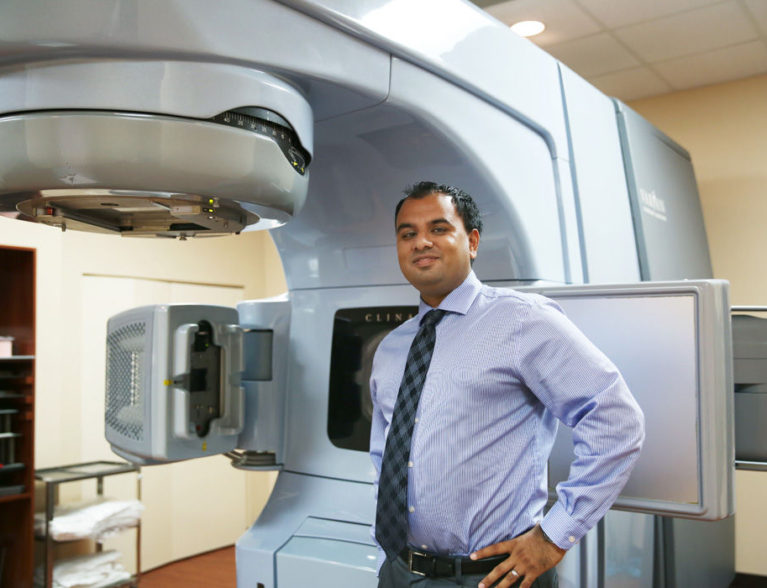
Dr. Rahul Chopra, a radiation oncologist, just had his first patient receive an advanced radiation procedure on a recently installed impressive piece of equipment at the Sebastian office of Cancer Care Centers of Brevard and Indian River County.
Dr. Chopra’s Sebastian facility is the only one in Indian River County accredited for radiation oncology by the American College of Radiology.
Chopra, a graduate of the University of Florida, came to Sebastian from the Florida Hospital in Orlando in 2012. His Sebastian office has just reopened after being closed since May 12 to install a Varian Clinac iX with onboard cone-beam imaging, a highly sophisticated platform which allows better targeting of cancer with onboard CT imaging.
This, Chopra explained, not only saves patient and clinic time, but also eliminates the need to move the patient from one machine to another. The Clinac iX, depending on whether it is new or pre-owned, can carry a price tag of more than $1.5 million.
In the past, before a cancer patient’s radiation treatment could begin, an initial, “planning” CT (computerized tomography) scan was performed to determine where the radiation beam should be focused, and the location was marked on the patient. With the target area established, the patient was placed on another table for the radiation treatment itself.
Then, during the series of treatments, to make sure the “mark” was hit, X-rays would be taken, typically only weekly, using the megavoltage treatment beam itself. This, Chopra continued, provided poor quality pictures, and the process was tedious, using actual film, in cassettes, and a special processor.
“We don’t use that anymore. Compared to what we have now,” Chopra said, “it was crude back then. “ When radiation oncologists began using kilovoltage, five to six years ago, the images were greatly improved, achieving “diagnostic quality.” As Chopra displayed an image taken with the megavoltage beam, next to one using kilovoltage, the difference was clear. “You can’t see much with a megavoltage beam.”
By comparison, while the patient is on the Clinac iX table, about to receive radiation, the radiation therapist can take an image, using a unit on board with the patient, “to make sure we’re treating in the right place.” Although there is no visual during the actual delivery of the radiation, the radiation therapist can pause during the treatment to get other images as needed.
While the patient is comfortably undergoing treatment, the radiation therapists are in another area at the streamlined command/control center from which virtually every aspect of treatment can be controlled, through a single keyboard. The patient can be monitored and all the levels tracked, during the entire procedure.
Before beginning a series of radiation treatments, specifics and appropriate levels for the individual patient are determined, which may take an hour or more. After that, the treatments typically take less than 20 minutes and are usually covered by Medicare.
Another treatment option for which the Clinac iX can be utilized is called radiosurgery. This treatment would be used, said Chopra, if a patient needs actual surgery but, for reasons including poor cardiac or lung function, or due to being a heavy smoker, he or she can’t tolerate invasive surgery. With radiosurgery, the patient receives a “super-high dose of radiation, over one to five days, instead of the standard, lower-dose, three- to eight-week course. It is radiation, not actual surgery, there is no cutting.”
Another advancement in radiology oncology is the ability to more precisely shape the radiation treatment, thus protecting the good tissue, while attacking the nearby cancer. The radiation beam can be shaped to curve around the cancerous area, a vast improvement from previous years when far more healthy tissue was damaged in order to destroy nearby cancer cells.
Radiopharmaceutical therapy, Chopra continued, is used for therapeutic purposes when cancer has spread all over the body, often in the treatment of lymphoma and to relieve the intense pain of bone cancer. “It is almost like a smart bomb,” he says, in the way it can home in on the “target” with fewer side effects than conventional chemotherapy. After consult and diagnosis, if radiopharmaceutical therapy is indicated, Chopra will administer it in the Melbourne facility, where the CCCB nuclear medicine facility and support staff are located.
Cancer Care Centers of Brevard was established in 1990 and currently has a staff of 80, including board-certified physicians, technicians, nurses, medical assistants and other support personnel, all dedicated to fighting cancer. It is of interest to note that eight staff members, including a physician, are cancer survivors themselves.
With a “philosophy of caring” coupled with cutting edge technology, the CCCB in Sebastian contributes significantly to the excellent health care available to North County.



